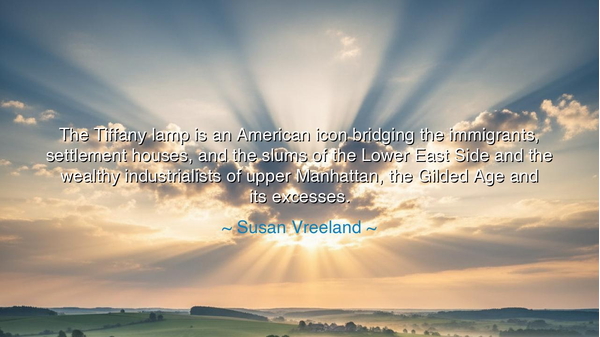
The Tiffany lamp is an American icon bridging the immigrants
The Tiffany lamp is an American icon bridging the immigrants, settlement houses, and the slums of the Lower East Side and the wealthy industrialists of upper Manhattan, the Gilded Age and its excesses.






In the words of Susan Vreeland, “The Tiffany lamp is an American icon bridging the immigrants, settlement houses, and the slums of the Lower East Side and the wealthy industrialists of upper Manhattan, the Gilded Age and its excesses.” These words shimmer with symbolism, for they speak not only of an object of beauty, but of a nation in transformation. The Tiffany lamp, with its mosaic of colored glass, becomes here a metaphor for America itself—a nation forged from fragments, luminous in diversity, and bound together by both struggle and art. Vreeland, a novelist of history and spirit, reminds us that beauty is not born in isolation; it rises from the meeting of worlds—the toil of the humble and the vision of the powerful, the sweat of the immigrant and the wealth of the elite.
In the late nineteenth century, during what came to be known as the Gilded Age, America was a land of dazzling progress and aching disparity. The rich built mansions adorned with chandeliers and stained glass, while the poor crowded into the narrow tenements of New York’s Lower East Side. Yet it was in this contrast that the Tiffany lamp was born. Designed under the direction of Louis Comfort Tiffany, these lamps were crafted not by machines, but by the hands of women—many of them immigrants—who worked in the studios of the Tiffany Glass Company. Known as the “Tiffany Girls,” they assembled the pieces that would later glow in the homes of the wealthy. Their labor, unseen yet essential, transformed fragments of glass into glowing works of art.
Thus, when Vreeland calls the lamp a bridge, she speaks of more than artistry—she speaks of connection across class, gender, and heritage. The light of the Tiffany lamp is not merely decorative; it is symbolic of the light born from unity. The immigrant who cut the glass, the artisan who shaped it, and the industrialist who displayed it—all became part of a shared creation. The lamp’s light is the meeting of their worlds: the sweat of labor illuminating the leisure of privilege. It stands as a silent witness to the paradox of the age—an age that produced both exploitation and art, both excess and excellence.
The story of Clara Driscoll, the woman long unrecognized for her leadership in Tiffany’s glass studios, deepens this truth. For decades, her contributions were forgotten, her name buried beneath that of Tiffany himself. Yet it was she who led the team of women who designed many of the company’s most exquisite lamps. Her rediscovered letters, found a century later, revealed the hidden labor of countless women whose hands shaped the very symbols of American beauty. The Tiffany lamp, then, is also a monument to their unseen genius, to the anonymous workers whose art glowed brightly even when their names were dimmed by history.
From this we learn that every great creation carries within it a story of many lives intertwined. The lamp’s glow is not just light—it is legacy. It reminds us that art is not born of privilege alone, but from the fusion of many forces, from the quiet endurance of those who dream in obscurity. Vreeland’s words urge us to look beyond the surface, to see the human stories behind every masterpiece, the hands behind the glory.
And so, the Tiffany lamp becomes more than an artifact of the Gilded Age—it becomes a parable of unity. Just as the glass fragments, when joined, create brilliance, so too does a society shine brightest when its diverse parts work in harmony. The immigrant, the artisan, the magnate—all are pieces of the same lamp, and the light that shines forth belongs to them all.
Let this, then, be the lesson: beauty is born from connection. Honor the unseen hands that build the world you enjoy. When you encounter art, progress, or comfort, look beyond its glow to the labor that kindled it. Seek not division, but integration; not domination, but collaboration. For like the Tiffany lamp, the human story gleams most brightly when the broken pieces are brought together in love, purpose, and shared creation.






AAdministratorAdministrator
Welcome, honored guests. Please leave a comment, we will respond soon